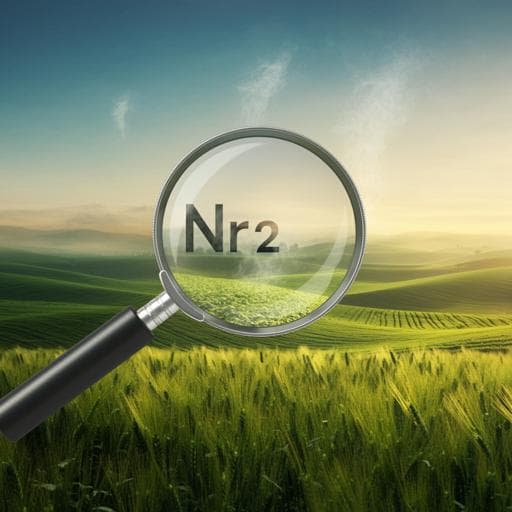
Environmental Studies and Forestry
The underappreciated role of agricultural soil nitrogen oxide emissions in ozone pollution regulation in North China
X. Lu, X. Ye, et al.
Explore groundbreaking research by Xiao Lu and colleagues revealing how soil nitrogen oxide emissions in the North China Plain drastically affect local ozone pollution. Their study uncovers an emission control penalty, emphasizing the need for larger reductions to meet air quality targets amidst rising pollution levels. Discover the implications for agricultural practices and atmospheric regulations.
~3 min • Beginner • English
Introduction
Surface ozone is a major pollutant harming health and vegetation, and summertime ozone in the North China Plain (NCP) is among the highest at northern mid-latitudes. Despite substantial reductions in anthropogenic NOx and particulate matter since 2013 under China’s clean air actions, warm-season ozone has continued to rise rapidly (∼3 ppbv year−1 over 2013–2019). Prior work attributes these increases to declines in PM and anthropogenic NOx and to meteorology, highlighting the complexity of ozone control. The NCP combines very high anthropogenic emissions with intensive agriculture (∼23% of China’s cropland and 30% of fertilizer use), implying substantial soil NOx emissions from microbial processes enhanced by fertilizer and nitrogen deposition. Yet, the role of soil NOx in modulating ozone formation and the effectiveness of anthropogenic emission controls in this NOx-rich region has been unclear and often neglected in models and policy design. This study tests the hypothesis that soil NOx substantially alters ozone sensitivity to anthropogenic emissions in the NCP, imposing an additional penalty on emission control strategies.
Literature Review
Observations and modeling indicate that ozone formation regimes in the NCP are typically transitional to NOx-saturated in urban/suburban zones and NOx-limited in rural areas. Previous studies suggested notable ozone enhancements from agricultural soil NOx in NOx-limited regions, but interactions with dense anthropogenic sources in NOx-rich regions like the NCP had not been evaluated. Many air quality assessments in China simplified or omitted soil NOx in source attribution, leaving the implications unknown. Satellite analyses have shown decreasing anthropogenic NOx since 2011, while field and top-down studies indicate substantial soil NOx in China (annual 0.48–1.38 Tg N a−1) with large uncertainty, especially linked to fertilizer applications and pulsing after wetting. This work builds on these insights by explicitly representing soil NOx and quantifying its interaction with anthropogenic emissions for ozone in the NCP.
Methodology
- Emissions and models: Applied two atmospheric chemistry models: GEOS-Chem v11-02 (nested over East Asia at 0.25° × 0.3125°) and WRF-Chem v3.6.1 (27 km) for July 2017. Anthropogenic emissions used the MEIC 2017 inventory. Natural/biogenic sources included biogenic VOCs (MEGAN2.1), biomass burning (GFED4), lightning NOx, and soil NOx via the Berkeley-Dalhousie Soil NOx Parameterization (BDSNP) in GEOS-Chem.
- Soil NOx estimation: BDSNP computes hourly grid-scale soil NOx emissions above canopy as a function of available soil nitrogen (natural pool, fertilizer, deposition), soil temperature, moisture (water-filled pore space), and wetting-induced pulsing. Fertilizer inputs were distributed across growing seasons; nitrogen deposition coupled to model chemistry. Uncertainty was explored by scaling Chinese soil NOx emissions by 0.5× and 2×.
- Observational constraints: Compared simulated tropospheric NO2 columns with three OMI products (POMINO, DOMINO v2.0, QA4ECV) using averaging kernels; excluded clouds >30%, snow, and row anomalies. Evaluated surface MDA8 ozone using CNEMC observations at 55 NCP cities.
- Scenario design in GEOS-Chem: Conducted a BASE run and sensitivity runs: zero-out anthropogenic emissions (NoAnthro), soil NOx (NoSoil), lightning NOx (NoLight), and their combinations to diagnose source contributions and nonlinear interactions. Performed graded reductions of Chinese anthropogenic NOx (20–100%) with and without soil NOx; repeated with joint reductions of NOx, VOCs, and CO. Used H2O2/HNO3 as a regime indicator.
- WRF-Chem setup: Same anthropogenic inventory; MEGAN2.1 biogenic VOCs. Replaced underestimated MEGAN soil NOx with offline monthly mean soil NOx from GEOS-Chem for July 2017. Ran BASE and BASE+Soil, with and without anthropogenic emissions, to cross-check soil effects.
- Ozone metrics: Evaluated responses of MDA8, NDGT70 (days with MDA8 >70 ppb), and AOT40 (cumulative daytime O3 >40 ppb) per TOAR definitions. Estimated required emission reductions for target MDA8 decreases (5–15 ppbv) using logarithmic fits.
Key Findings
- Emission magnitudes and shares:
- July 2017 anthropogenic NOx emissions over China: 0.53 Tg N (0.16 Tg N in NCP); soil NOx in NCP: 0.03 Tg N (∼11–20% of anthropogenic in July 2008–2017), with 58% from fertilizer-induced emissions.
- Annual soil NOx emissions above canopy (2008–2017): China 0.77 ± 0.04 Tg N a−1; NCP 0.18 ± 0.01 Tg N a−1; peak monthly NCP emissions in May–July (∼0.034 ± 0.003 Tg N month−1).
- Satellite constraint:
- GEOS-Chem with soil NOx matches OMI NO2 over NCP within ∼5% mean differences; excluding soil NOx yields −12% to −20% low bias (P<0.01), particularly where anthropogenic/soil emission ratios are low.
- Ozone levels and model skill:
- Observed urban MDA8 ozone in NCP (July 2017) ≈ 70.3 ± 8.6 ppbv; GEOS-Chem ≈ 72.4 ± 5.6 ppbv (r=0.72; mean bias ≈ +2 ppbv across 55 cities).
- Suppression of anthropogenic ozone contribution by soil NOx:
- GEOS-Chem: Anthropogenic ozone enhancement (BASE − NoAnthro) averages 21.2 ppbv with soil vs 30.7 ppbv without soil in the NCP (−30%; range −19% to −46% under 0.5×–2× soil scaling). Mean difference 9.5 ppbv.
- WRF-Chem: Anthropogenic ozone enhancement 40 ppbv with soil vs 60 ppbv without soil (−30%).
- Regime shift and sensitivity:
- H2O2/HNO3 averages ∼0.2 in BASE (transitional/NOx-saturated). As anthropogenic NOx is reduced, H2O2/HNO3 increases and exceeds 1 at >80% reductions; excluding soil NOx shifts regimes toward NOx-limited at higher anthropogenic NOx levels.
- Soil ozone contribution depends on anthropogenic NOx:
- Soil NOx contributes ∼2.9 ppbv O3 under BASE conditions (1.7–4.6 ppbv with 0.5×–2× soil). With all domestic anthropogenic NOx off, soil-driven O3 rises to ∼15 ppbv (9–23 ppbv), offsetting expected decreases.
- Different spatial impacts and efficiencies:
- Removing soil NOx lowers NCP July mean surface O3 by 2.9 ppbv; a comparable absolute NOx reduction from anthropogenic sources (−20%) lowers O3 by 1.7 ppbv, with urban increases in NOx-saturated cities (e.g., Beijing, Tianjin, Shijiazhuang). Soil NOx has higher ozone production efficiency (OPE; e.g., 36.4 vs 8.3 units reported) and longer-lived ozone in rural/high-soil areas.
- Ozone metric responses to controls (GEOS-Chem, NCP cities):
- −20% anthropogenic NOx: with soil NOx, MDA8 −1.4%, AOT40 −2.3%, NDGT70 −4.6%; without soil, MDA8 −2.6%, AOT40 −5.5%, NDGT70 −12%.
- −60% anthropogenic NOx: with soil NOx, MDA8 −8.8%, AOT40 −18%, NDGT70 −34%; without soil, MDA8 −15%, AOT40 −33%, NDGT70 −58%.
- Soil NOx emission penalty (extra required reductions to reach target MDA8 decreases):
- Controlling NOx only: additional ∼13% (for 5 ppbv target) and ∼15% (for 15 ppbv target) reductions required when soil NOx is present versus absent.
- Joint NOx+VOCs+CO controls: penalty reduced to ∼3.8% (5 ppbv) and ∼10% (15 ppbv).
Discussion
The study demonstrates that substantial agricultural soil NOx emissions in the NCP materially suppress the sensitivity of surface ozone to anthropogenic emission reductions. By maintaining NOx availability, soil emissions keep urban and regional chemistry in a more NOx-saturated or transitional regime, thereby diminishing the ozone decrease per unit anthropogenic NOx reduction. As anthropogenic NOx declines, the system becomes more NOx-limited and the ozone formed per unit soil NOx increases, partially offsetting expected ozone benefits from anthropogenic controls. This interaction explains why models that omit soil NOx overestimate the effectiveness of anthropogenic emission controls and underestimate the required control effort to meet ozone targets. The consistent 30% reduction in estimated anthropogenic ozone enhancement across GEOS-Chem and WRF-Chem underscores robustness. These results clarify the role of soil NOx as a critical modulator of ozone response in NOx-rich, agriculture-intensive regions, informing more realistic policy planning that integrates both anthropogenic and agricultural nitrogen management.
Conclusion
Soil NOx emissions, largely driven by fertilizer use and nitrogen deposition, are a significant and underappreciated factor governing ozone pollution control in the NCP. While soil NOx raises July mean ozone by only a few ppbv under current conditions, it reduces the achievable anthropogenic ozone improvement by about 30% and imposes a soil emission penalty: an additional 13–15% anthropogenic NOx reduction (or 3.8–10% for joint NOx+VOCs+CO controls) is required to achieve 5–15 ppbv MDA8 reductions in NCP cities. As combustion-related NOx continues to decline, the relative importance of soil NOx will grow. Future efforts should incorporate soil NOx (and related HONO emissions) in emission control strategies and inventories, improve constraints via targeted measurements, and explore mitigation via optimized fertilizer application. The implications likely extend to other regions with co-located high anthropogenic and agricultural emissions, such as the Indo-Gangetic Plain.
Limitations
- Soil NOx emission uncertainties remain large (order-of-two), stemming from fertilizer application data, meteorology (soil moisture/temperature), pulsing from wetting, and parameterization limits; sensitivity tests (0.5×–2×) indicate conclusions are robust but quantitative ranges vary.
- Ozone formation regime diagnostics (e.g., H2O2/HNO3 thresholds) are region- and condition-dependent, adding uncertainty to regime classification.
- Model structural differences (chemical mechanisms, background sources, and resolution) lead to different absolute anthropogenic ozone contributions (e.g., GEOS-Chem vs WRF-Chem), though the relative soil suppression effect is consistent.
- WRF-Chem used offline soil NOx from GEOS-Chem for July 2017, which may not capture full temporal variability; MEGAN’s native soil NOx is known to be underestimated.
- The analysis focuses on July (peak soil emissions/ozone) and the NCP; seasonality and other regions may show different magnitudes.
- Direct, widespread field measurements of soil NOx (and HONO) in the NCP are limited, constraining validation and mechanistic refinement.
Related Publications
Explore these studies to deepen your understanding of the subject.







